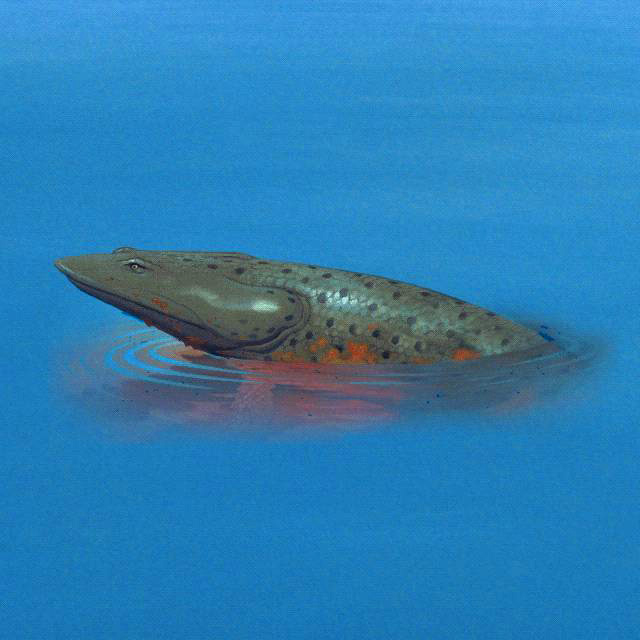Elpistostegalians
Elpistostegalians are the closest ancestors of tetrapods, displaying characteristics of both fish and tetrapods.
 (24 kb) Similar to fish, they have a body covered in scales, gills, rays at the tips of their fins, and a pair of jugal plate under the lower jaw. They resemble tetrapods with their large skull size, the flattened skull shape from back to front, a long snout with respect to total skull length, eyes on top of the skull, and no dorsal or anal fins. Moreover, the skull bone pattern includes two frontal bones, which did not exist in other sarcopterygians, as well as enlarged laterally-oriented ribs.
(24 kb) Similar to fish, they have a body covered in scales, gills, rays at the tips of their fins, and a pair of jugal plate under the lower jaw. They resemble tetrapods with their large skull size, the flattened skull shape from back to front, a long snout with respect to total skull length, eyes on top of the skull, and no dorsal or anal fins. Moreover, the skull bone pattern includes two frontal bones, which did not exist in other sarcopterygians, as well as enlarged laterally-oriented ribs.
Elpistostegalians lived within a very narrow timeframe of just a few million years during the Upper Devonian. Four species are known: Elpistostege in Miguasha, which gave its name to the group; two Panderichthys species in Latvia; and Tiktaalik, found recently on Ellesmere Island in the Canadian Arctic. When alive, these animals swam in deltas and estuaries near the continental shores of Euramerica, which straddled the equator at the time. It was along these shores that the first true tetrapods, equipped with digits, appeared at the end of the Frasnian Age during Upper Devonian time.

 (32 kb)Elpistostegalians and tetrapods were not only similar in morphology, but the periods and habitats in which they lived also coincided. Vaguely resembling little crocodiles with fins, these fish lived in shallow water, breathed air into their lungs, and could peek above the surface with their prominent eyes.
(32 kb)Elpistostegalians and tetrapods were not only similar in morphology, but the periods and habitats in which they lived also coincided. Vaguely resembling little crocodiles with fins, these fish lived in shallow water, breathed air into their lungs, and could peek above the surface with their prominent eyes.
The fins of Tiktaalik are sufficiently well-preserved to be studied in detail. In addition to having the classic sarcopterygian structure (humerus, cubitus and radius), the fin could be turned downward and bent slightly forward at its “elbow”. It wouldn’t be surprising if this limb not only helped Tiktaalik rest on the bottom, but also allowed it to crawl on land when needed.

 (24 kb) Similar to fish, they have a body covered in scales, gills, rays at the tips of their fins, and a pair of jugal plate under the lower jaw. They resemble tetrapods with their large skull size, the flattened skull shape from back to front, a long snout with respect to total skull length, eyes on top of the skull, and no dorsal or anal fins. Moreover, the skull bone pattern includes two frontal bones, which did not exist in other sarcopterygians, as well as enlarged laterally-oriented ribs.
(24 kb) Similar to fish, they have a body covered in scales, gills, rays at the tips of their fins, and a pair of jugal plate under the lower jaw. They resemble tetrapods with their large skull size, the flattened skull shape from back to front, a long snout with respect to total skull length, eyes on top of the skull, and no dorsal or anal fins. Moreover, the skull bone pattern includes two frontal bones, which did not exist in other sarcopterygians, as well as enlarged laterally-oriented ribs.Elpistostegalians lived within a very narrow timeframe of just a few million years during the Upper Devonian. Four species are known: Elpistostege in Miguasha, which gave its name to the group; two Panderichthys species in Latvia; and Tiktaalik, found recently on Ellesmere Island in the Canadian Arctic. When alive, these animals swam in deltas and estuaries near the continental shores of Euramerica, which straddled the equator at the time. It was along these shores that the first true tetrapods, equipped with digits, appeared at the end of the Frasnian Age during Upper Devonian time.

 (32 kb)Elpistostegalians and tetrapods were not only similar in morphology, but the periods and habitats in which they lived also coincided. Vaguely resembling little crocodiles with fins, these fish lived in shallow water, breathed air into their lungs, and could peek above the surface with their prominent eyes.
(32 kb)Elpistostegalians and tetrapods were not only similar in morphology, but the periods and habitats in which they lived also coincided. Vaguely resembling little crocodiles with fins, these fish lived in shallow water, breathed air into their lungs, and could peek above the surface with their prominent eyes.The fins of Tiktaalik are sufficiently well-preserved to be studied in detail. In addition to having the classic sarcopterygian structure (humerus, cubitus and radius), the fin could be turned downward and bent slightly forward at its “elbow”. It wouldn’t be surprising if this limb not only helped Tiktaalik rest on the bottom, but also allowed it to crawl on land when needed.
Site map | Feedback | Links | Sources | Credits
Elpistostegalians
<< Eusthenopteron | Elpistostege >>




